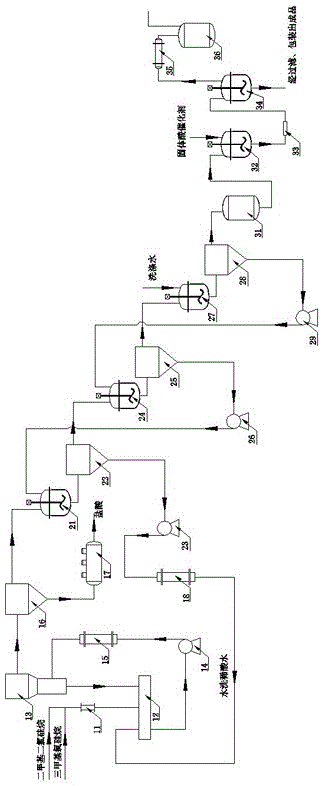Continuous preparing technology for low-viscosity simethicone
A technology for the preparation of simethicone oil, which is applied in the field of continuous preparation of low-viscosity simethicone oil, can solve the problems of affecting the quality of simethicone oil, telomerization cannot be completely eliminated, and easy introduction of silicon hydroxyl groups, etc., to achieve shortening The effect of lowering time, lower production process cost and improving product yield
- Summary
- Abstract
- Description
- Claims
- Application Information
AI Technical Summary
Problems solved by technology
Method used
Image
Examples
Embodiment 1
[0034] A continuous preparation process of low-viscosity simethicone oil is carried out as follows:
[0035] Raw material feed ratio is as follows:
[0036] Trimethylchlorosilane: 10kg / h; Dimethyldichlorosilane: 280kg / h; Dilute acid water: 580kg / h
[0037] a. Hydrolysis
[0038] Trimethylchlorosilane and dimethyldichlorosilane are preliminarily mixed in the static mixer 11 at a ratio of 1:28 and then enter the tubular hydrolysis reactor 12 to react with dilute acid water. The dilute acid water here is dilute hydrochloric acid with a mass concentration of 0.8% (the washing water after the primary water washing in the washing process of the last kettle material can also be used). The hydrolysis temperature of the material in the hydrolysis reactor 12 is controlled at 30°C. After the feeding is completed, the residence time of the material in the hydrolysis system is 10 minutes. The material is transported to the hydrolysis cooler 15 for heat exchange through the hydrolysis ci...
Embodiment 2
[0053]A continuous preparation process of low-viscosity simethicone oil is carried out as follows:
[0054] Raw material feed ratio is as follows:
[0055] Trimethylchlorosilane: 10kg / h; Dimethyldichlorosilane: 280kg / h; Dilute acid water: 500kg / h
[0056] a. Hydrolysis
[0057] Trimethylchlorosilane and dimethyldichlorosilane are preliminarily mixed in the static mixer 11 at a ratio of 1:28 and then enter the tubular hydrolysis reactor 12 to react with dilute acid water. The dilute acid water here is dilute hydrochloric acid with a mass concentration of 0.8% (the washing water after the primary water washing in the washing process of the last kettle material can also be used). The material is controlled in the hydrolysis reactor 12 at a hydrolysis temperature of 40° C., and stays for 8 minutes. The material is transported to the hydrolysis cooler 15 for heat exchange through the hydrolysis circulation pump 14, and then enters the pre-separator 13 for pre-separation, and the...
Embodiment 3
[0072] A continuous preparation process of low-viscosity simethicone oil is carried out as follows:
[0073] Raw material feed ratio is as follows:
[0074] Trimethylchlorosilane: 15kg / h; Dimethyldichlorosilane: 285kg / h; Dilute acid water: 600kg / h
[0075] a. Hydrolysis
[0076] Trimethylchlorosilane and dimethyldichlorosilane are preliminarily mixed in the static mixer 11 at a ratio of 1:19 and then enter the tubular hydrolysis reactor 12 to react with dilute acid water. The dilute acid water here is dilute hydrochloric acid with a mass concentration of 0.8% (the washing water after the primary water washing in the washing process of the last kettle material can also be used). The material is controlled in the hydrolysis reactor 12 at a hydrolysis temperature of 30° C., and is held for 10 minutes. The material is transported to the hydrolysis cooler 15 for heat exchange through the hydrolysis circulation pump 14, and then enters the pre-separator 13 for pre-separation, and...
PUM
 Login to View More
Login to View More Abstract
Description
Claims
Application Information
 Login to View More
Login to View More - R&D
- Intellectual Property
- Life Sciences
- Materials
- Tech Scout
- Unparalleled Data Quality
- Higher Quality Content
- 60% Fewer Hallucinations
Browse by: Latest US Patents, China's latest patents, Technical Efficacy Thesaurus, Application Domain, Technology Topic, Popular Technical Reports.
© 2025 PatSnap. All rights reserved.Legal|Privacy policy|Modern Slavery Act Transparency Statement|Sitemap|About US| Contact US: help@patsnap.com

